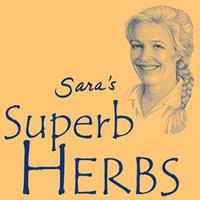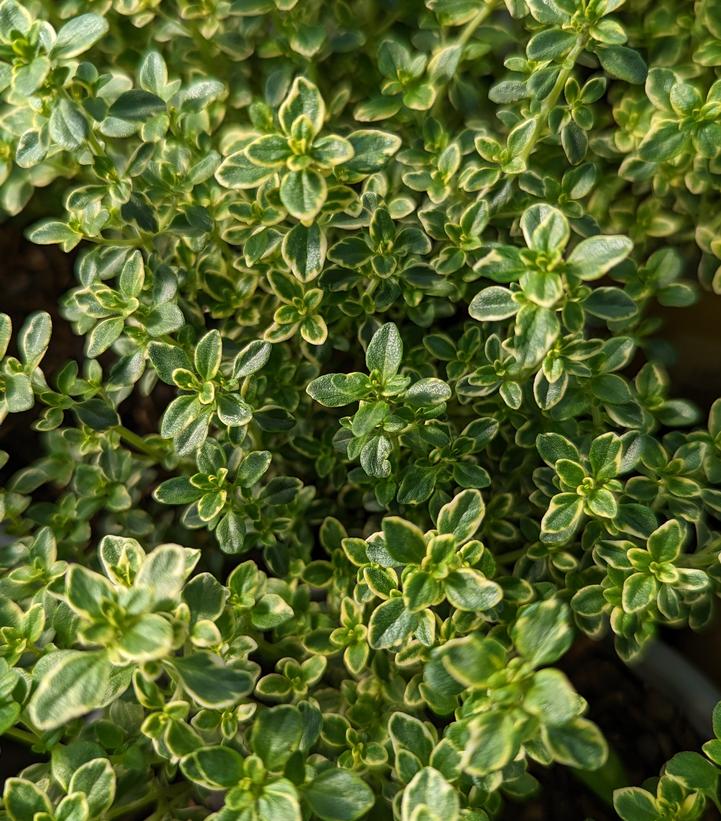« Previous Plant | Next Plant »
Thymus citriodorus 'Aureus'
Lemon Thyme
- » Great texture
- » Tiny deep, green foliage edged in bright gold
- » Mounding, spreading form
- » Great for cooking, teas, aromatherapy and more
- » Strong lemon scent
- » Easy to grow
- » Great in containers, windows, or for cutting
- » Perennial

- Category:Edibles
- Breeder:Sara's Superb Herbs®
- Hardiness Zone:5-8
- Height:4-6 in
- Spread:20-24 in
- Bloom Color: Green Shades
- Foliage Color: Green Shades, Yellow Shades
What a showy plant! You'll love this plant's great texture but you'll marvel at its tiny deep green foliage edged in the brightest gold. Golden lemon thyme makes a great show in the garden as it mounds and spreads but its real beauty is its array of uses in cooking, teas, aromatherapy, and more! Its strong lemon scent is a breath of fresh air and it's such an easy plant to grow. It's perfect for full sun and loves growing in containers on a deck or in a sunny window where you'll be tempted to cut it repeatedly just for the joy of that strong citrus aroma! Perennial.
Additional Information about Thymus citriodorus 'Aureus'
T. x citriodorus 'Aureus' is a small, upright, spreading plant with gold-splashed leaves that are prettily colorful. It grows to 6" tall with a 24" spread. Good as an ornamental and a culinary. The lemon scent and taste make it excellent with fish, lemon flavored vinegars, and herb butters. It is truly beautiful in a rock garden, or along a wall or pathway.
It was believed that fairies made their homes in patches of thyme, and gardeners of old set aside patches for them. In the Middle Ages, it represented chivalry. In France, it represented the Republican spirit. It was a flavor in liqueurs and cheese. Caraway thyme became the choice seasoning for beef. It was used medicinally to treat epilepsy, melancholy, the plague, and as an antiseptic on the battlefield in World War I. Thyme tea was believed to give shy persons courage and to alleviate nervous disorders and even nightmares.
Harvest and Use: Thyme is one of the fines herbes in French cuisine. This is a combination of minced chervil, parsley, thyme, and tarragon. The blend is appreciated for its freshness and its satisfying taste. It is added to food at the very last minute of cooking. Thyme is also one of the herbs in the classic blend called bouquet garni. This blend is tied in a cheesecloth bag or tucked between two stalks of celery and tied together to give flavor to the dish without the flecks. A bouquet garni includes thyme, parsley, bay, peppercorns, whole allspice, cloves, and marjoram. Tie it to the handle of the pot for easy removal.
Thyme, like parsley, goes with everything-veal, lamb, beef, poultry, fish, stuffing, stews, soups, sauces, stock, herb butters, flavored vinegars, beans, lentils, potatoes, tomatoes, cheese, onions, cucumbers, carrots, eggplant, leeks, mushrooms, eggs, and rice. I use it in every blend and with any food. If you ever find thyme-flavored honey, do not pass up this gourmet treat!
The essential oil is used to treat fatigue, depression, headache, respiratory problems and muscular pain. It is used in cough medicine. Mix it with a carrier oil and use as a chest rub. Apply it to insect bites and infected wounds. Add a few drops of pure essential oil to bathwater for weakness and arthritic conditions. Infusions are taken for flatulence, painful menstruation, chest infections marked by thick, yellow phlegm, stomach chills associated with diarrhea, and to gargle with for a sore throat. It blends well with bergamot, citrus oils, lemon balm, and rosemary. It has been shown to increase the production of white blood corpuscles in the presence of infections.
Thyme has uses other than medicinal and culinary. Add it to lavender to use as a moth repellent. The leaves and flowers make lovely sachets and can be added to potpourri. Thymol, one of its chemical constituents, which is also found in bee balm, has been used in colognes, aftershave lotions, soaps, detergents, toothpaste, mouthwash, and in external preparations for rheumatism. Thyme is antiseptic, stimulating, and a good cleanser, making it a good choice for an herbal bath.
Harvest small amounts throughout the season as needed. Cut back 2" from the ground for your main harvest in late summer. Taking a second harvest before winter may make plants less able to survive a cold, wet winter. To dry, tie bunches and hang in a warm, shady, airy site. Or you can strip the leaves from the stems and dry them on a close-meshed screen. Store in a tight-lidded jar in a cool, dark place. Thyme can also be frozen.
